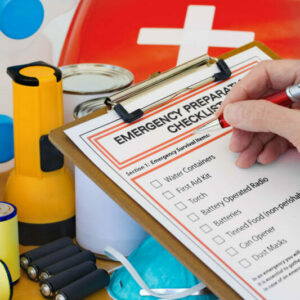Each September, the US Department of Homeland Security observes National Preparedness Month as a way to promote awareness and share plans for individuals, families and communities in preparing for emergencies and disasters. OSHA also requires businesses to create emergency preparedness plans to protect workers before an emergency or disaster occurs (19 CFR 1926 and 29 CFR 1910). Emergencies can occur at any time. Proper planning ahead of time is imperative to the success of family and employees responding quickly and efficiently in emergency situations.
This year’s National Preparedness Month theme is “Prepare to Protect”. Preparing for disasters is protecting everyone you love. Anyone can utilize the tools and weekly themes to prepare for home or business disasters and emergencies.
Week 1 – Make A Plan
Home – Talk to family about how you will communicate before, during and after a disaster or emergency. Create a fire evacuation map and agree on a meeting location for all family members to meet during an emergency.
Business – Create detailed evacuation and response procedures. Check alarm systems and create notification procedures. Designate emergency exits and routes. Establish roles and responsibilities for those in charge. Designate assembly area
Week 2 – Built a Kit
Home – Gather supplies that will last for several days after a disaster for everyone living in your home. Don’t forget to consider the unique needs each person or pet may have in case you have to evacuate quickly. Update your kits and supplies regularly.
Business – A business will not build a kit so to speak, but they will need to review specific hazards in their facility or at a job site and plan accordingly. Hazards to think about include:
- Hazardous Materials – management of highly hazardous chemicals, hazardous waste operations and emergency response
- Proper Personal Protective Equipment – selection based on a PPE assessment
- Confined Spaces and Lockout/Tagout controls
- Medical and First Aid stations – eyewash stations
- Fire Protection – fire suppression equipment, fire detection systems, alarms
- Bloodborne Pathogens
- Hazard Communication
Week 3 – Prepare for Disasters
Home – Know the risk of disasters in your area and check your insurance coverage.
Business – Know the risk of disasters in your area and how they would impact your workplace. A workplace emergency can affect workers, customers or the public; disrupt or shut down operations; or cause physical or environmental damage. Emergencies may be natural or man-made, and may include hurricanes, tornadoes, earthquakes, floods, wildfires, winter weather, chemical spills or releases, disease outbreaks, releases of biological agents, explosions involving nuclear or radiological sources, and many other hazards.
Week 4 – Teach About Preparedness
Home – Talk to your children about preparing for emergencies and the plans you have made to keep them safe. Make sure they know all emergency routes and meeting areas. Discuss what do to if something goes wrong with the plan and what a backup plan should be.
Business – Train employees. Employees should receive training upon initial assignment and annually thereafter; when special assignments are designated; when new equipment or processes are introduced; and when procedures are revised. Employers should conduct annual evacuation and preparedness drills.
Let OECS help you make sure you Have a Plan
No one knows when an emergency or disaster will strike. Preparedness plans are critical in the success of keeping your family and workers safe.
For more information on National Preparedness Month click here or for businesses looking for OSHA guidance on emergency preparedness plans click here.
Ensure you are prepared for your company’s next inspection with help from OECS. Contact us today to learn more about our workplace safety solutions.
 763.417.9599
763.417.9599
